 |
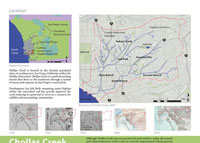 |
 |
 |
Although Chollas Creek was once an asset for early settlers, today, the natural and cultural functions of the creek are severely comprised. Ninety percent f the land has been developed and is cross cut by several major freeways, heavily used roads and residential, industrial and commercial land uses.
(Photo: Garrison, C.C. LaGrange, Mario Benito, Emily Kiefer, Google Maps 2007, http://history.sandiego.edu) |
 |
 |
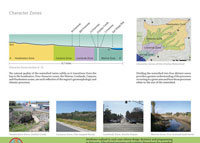 |
 |
 |
Attributes realized in each zone inform design decisions and programming in that zone. Education programs and activities throughout the watershed can be developed to highlight the unique character of each zone to increase awareness of the systematic nature of the watershed.
(Photo: Garrison, C.C. LaGrange, Mario Benito, Emily Kiefer, Google Maps 2007, http://history.sandiego.edu) |
 |
 |
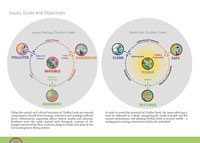 |
 |
 |
Issues, Goals and Objectives
(Photo: Garrison, C.C. LaGrange, Mario Benito, Emily Kiefer, Google Maps 2007, http://history.sandiego.edu) |
 |
 |
 |
 |
 |
The coastal California gnatcatcher served as umbrella species: by planning for this sensitive species, habitat requirements for naturally co-occurring species will be met. To help in the restoration process and cultivate stewards, schools can develop and implement restoration -related curriculums.
(Photo: Garrison, C.C. LaGrange, Mario Benito, Emily Kiefer, Google Maps 2007, http://history.sandiego.edu) |
 |
 |
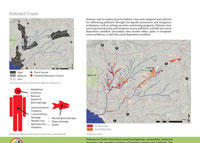 |
 |
 |
Pollution in Chollas Watershed comes from highways, automobiles, industrial processes and everyday activities of business owners and residents. For example, near the mouth of Chollas Creek, industrial developments and major freeway crossing contribute to high concentrations of heavy metals.
(Photo: Garrison, C.C. LaGrange, Mario Benito, Emily Kiefer, Google Maps 2007, http://history.sandiego.edu) |
 |
 |
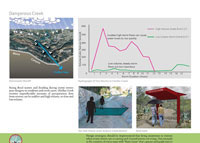 |
 |
 |
Design strategies should be implemented that bring awareness to visitors when storm events are occurring and channel waters are rising. One example is the creation of entry ways with "Rain Gates" that capture and guide rain to form a cascade of water.
(Photo: Garrison, C.C. LaGrange, Mario Benito, Emily Kiefer, Google Maps 2007, http://history.sandiego.edu) |
 |
 |
 |
 |
 |
Restoration, organized clean-ups and redirecting development to face the creek are several methods for enhancing the visibility of the creek. In addition, marketing tools can be employed, such as creative buttons which can be earned and collected by budding stewards.
(Photo: Garrison, C.C. LaGrange, Mario Benito, Emily Kiefer, Google Maps 2007, http://history.sandiego.edu) |
 |
 |
 |
 |
 |
 |
 |
 |
 |
 |
|
|
 |
 |
 |
ANALYSIS AND PLANNING HONOR AWARD
Kids at the Creek:
Planting the Seeds of Stewardship in Chollas Creek
Jacey Garrison, Student ASLA, Emily Kiefer, Student ASLA, Ceanatha La Grange, Student ASLA and Mario Benito, Student ASLA
California State
Polytechnic University Pomona, Pomona,
California
Faculty Advisors: Ken McCown, ASLA; Joan H. Woodward, FASLA; Phil Pregill, ASLA; Doug Delgado |
 |
 |
Project Statement:
Kids at the Creek focuses on the creation of
a new generation of environmental stewards to address
the challenges facing urbanized watersheds. By creating
stewards through education, community participation
and design, this unique two-pronged action and awareness
plan goes beyond scientific studies and regulatory policies.
Changing the mindset of people and how they approach
wildlife, in combination with ecological planning, is
the only way to achieve a symbiotic relationship between
people and nature.
Project Narrative:
Today, the natural and cultural functions
of Chollas Creek are severely compromised. Runoff from
housing, industries and roadways pollutes the water.
Urbanization negatively affects habitat quality and
quantity. Residents treat the creek channel with disregard.
They are cautious of the dangers presented by illicit
activities along its banks and wary of the fast-moving
water during storms.
These issues contribute to the invisibility
of the creek in both the physical landscape and residents’
consciousness. Many residents are unaware of the creek’s
presence, its history as a resource for early inhabitants
of the area or its potential to become a resource in
the future. Some community members regard the creek
as “nothing more than a big sewer line”
. The dumped trash, invasive species and neglected places
along Chollas Creek are evidence of this type of attitude.
Thus, the invisibility of the creek is both a cause
of, and contributor to, the issues affecting Chollas
Creek. The creek is degraded, polluted, dangerous and
invisible.
Despite these issues, many assets exist
within the watershed, including lengths of unchannelized
creekbed, a variety of native plant and animal species
and strong community groups. In order to reveal the
potential of Chollas Creek, the issues affecting it
must be addressed as a whole, integrating the needs
of people and the natural environment, and allowing
Chollas Creek to become visible – a unifying force
among communities within the watershed.
Environmental historian William Cronon
advocates the integration of people with conservation
efforts through the exploration of a “middle ground”
between the human and nonhuman as solutions are sought
for environmental challenges. Cronon argues that traditional
approaches to conservation that exclude humans from
nature can lead to dismissive attitudes toward the environment.
The physical results of this type of dismissive
attitude are visible within Chollas Watershed, where
some people view the creek as a dumping ground and nuisance
rather than a resource to be cared for, protected and
enjoyed. Areas that have been ecologically restored
are subject to these abuses: discarded mattresses and
graffiti mar a recent multi-million-dollar restoration
effort near the mouth of the creek.
By acknowledging the potential middle
ground between culture and nature, appropriate restoration
strategies that consider not only what is ecologically
plausible within the watershed, but also what is socially
acceptable, valued and sustainable, can emerge for Chollas
Creek. This type of restoration ethic, which looks “forward
to the potential of nature rather than backward to what
nature was in the past” can encourage urban community
members to respect and enjoy nature within Chollas Watershed.
Any successful plan for reviving Chollas
Creek must include strategies for connecting people
with nature in order to change current attitudes toward
the creek, the watershed and the greater natural environment.
Environmental data relating to the watershed’s
physical characteristics, including topography, location
of creek tributaries, climate and hydrology was collected
and studied. Pollution data relating to soil, water
and aquatic life were gathered and synthesized, including
a comprehensive review of current pollution regulations
and policies. Ecological maps including biological core
areas, wildlife linkages and habitat types were studied,
and extensive research into sensitive and endangered
plants and animals was conducted. Social data included
information about the history of the watershed from
pre-conquest through industrialization. Detailed studies
of the communities within the watershed were conducted,
and on-site evaluations of stream characteristics within
each community were performed. Information such as school
locations, school performance, policies and previous
efforts to improve the creek were also gathered and
analyzed.
The analysis was centered on the idea
of finding the middle ground between culture and nature
for restoration within the urban context. The analysis
developed a two-pronged approach that began with the
exploration of ways to create new environmental stewards.
Methods of creating stewards were researched and tested
for their potential applicability to the Chollas Watershed.
The second prong of the analysis looked at how best
to preserve and enhance environmental function within
the watershed in a way that included the human habitants
of the watershed, rather than excluded them.
The results of the analysis are a plan
that identifies the best places to begin projects that
will create stewards, classifications of different types
of stewards, design guidelines that will encourage the
formation of all types of stewards and will encourage
them to interact with
nature while still protecting native wildlife, as well
as the identification of areas that must be preserved
to maintain remaining ecological integrity.
Options were evaluated for how well they
encouraged community members to become stewards who
are involved in the restoration and enhancement of the
watershed. These options were also evaluated for their
potential to contribute to the ecological restoration
of Chollas Creek. Chosen options promote the creation
of stewards of the creek while also contributing to
the ecological improvement of the creek.
Interested parties were invited to two
community meetings which allowed residents to record
their current concerns about the creek and their visions
for its future. A creek walk helped expose the client
to the challenges and potentials of restoration, and
a classroom exercise with school children demonstrated
the necessity of actively creating stewards.
Design was integral to the process and
was used to explore the development of stewards and
the compatibility of creating spaces that serve the
needs of urban residents and native plants and animals.
Design charettes led to the development of materials,
textures, and sensory stimuli that would inspire stewards.
Educational design was also a key part of the process,
and a variety of techniques were explored to convey
ideas and knowledge to landscape users. Design was also
an important part of the process of exploring land use
compatibility. Through design the physical manifestation
of the differing levels of human interaction were depicted,
and compatible solutions were discovered.
The project will be implemented by a local
grassroots organization, Groundwork San Diego Chollas
Creek (“GWSDCC”). Encouraged to begin by
raising awareness of the creek and creating stewards
who will be active in its restoration, this non-profit
group has already begun engaging community members and
coordinating creek walks.
To facilitate implementation, the project
report contains lists of action items at the end of
each issue. These actions are divided into two categories,
outreach and policy, to further clarify the planning
method developed for this watershed and guide GWSDCC
in their implementation efforts. Also included in the
report are captivating graphics and templates that can
be used to spread information about the creek.
Design guidelines are included in the
report to help with site specific design, and two site
scale examples which detail how GWSDCC can implement
the plan are also included in the report. The beginning
stages of community outreach for these two sites have
been completed by the project team, and are a starting
point for the development of stewards at these sites.
Monitoring will be the responsibility
of newly created stewards as well as GWSDCC and local
affiliate organizations of the watershed. Detailed descriptions
of monitoring strategies for each issue are listed in
the evaluation section of the final Kids at the Creek
document. The evaluation goals should be used as tools
to gauge the success of the plan within the watershed.
1 GWSDCC.S Feasibility
Study and Strategic Plan. San Diego, 2006.
2 Cronon, William. The Trouble with Wilderness:
or, Getting Back to the Wrong Nature. In Uncommon Ground:
Toward Reinventing Nature, edited by William Cronon.
New York: W.W. Norton & Co., 1995.
3 Gobster, Paul and Hull, Bruce. “Which
Nature?” In Restoring Nature: Perspectives from
the Social Sciences and Humanities, by Paul Gobster
and Bruce Hull. Covelo: Island Press, 2000.
|
|
|
|
 |
 |
 |
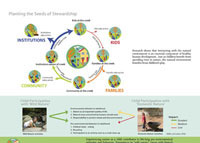 |
 |
 |
Experiencing nature as achild contributes to life-long pro-environmental attitudes and behaviors. Experiences in "wild nature" (areas with limited human management) and in "domestic nature" (areas with intensive human management) can contribute to these positive attitudes.
(Photo: Garrison, C.C. LaGrange, Mario Benito, Emily Kiefer, Google Maps 2007, http://history.sandiego.edu) |
 |
 |
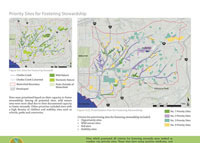 |
 |
 |
Sites which possessed all criteria for fostering stewards were ranked as number one priority sites. These sites have many positive attributes, and transforming them into places that promote stewardship will require relatively fewer resources.
(Photo: Garrison, C.C. LaGrange, Mario Benito, Emily Kiefer, Google Maps 2007, http://history.sandiego.edu) |
 |
 |
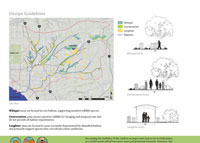 |
 |
 |
Increasing the visibility of the creek is an important step to its revitalization, as a visible creek will attract more users and potential stewards. However, due to the sensitive nature of habitat in the watershed, different types of human uses should be encouraged at different sites for fostering stewardship.
(Photo: Garrison, C.C. LaGrange, Mario Benito, Emily Kiefer, Google Maps 2007, http://history.sandiego.edu) |
 |
 |
 |
 |
 |
This two-pronged approach provides guidelines and strategies for developing sites in a way that helps reconnect people to nature while improving the physical condition of the watershed.
(Photo: Garrison, C.C. LaGrange, Mario Benito, Emily Kiefer, Google Maps 2007, http://history.sandiego.edu) |
 |
 |
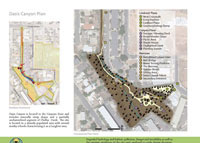 |
 |
 |
Degraded hydrology and habitat, pollution, danger and invisibility as well as the existing attributes of the site were analyzed to guide design decisions. Each design element functions to address conditions present at the site.
(Photo: Garrison, C.C. LaGrange, Mario Benito, Emily Kiefer, Google Maps 2007, http://history.sandiego.edu) |
 |
 |
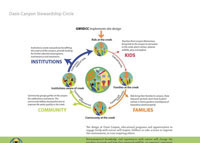 |
 |
 |
Environmental knowledge and experiences with nature will change the mindset of people and how they approach wildlife, an essential component for creating ecological balance between humans and nature.
(Photo: Garrison, C.C. LaGrange, Mario Benito, Emily Kiefer, Google Maps 2007, http://history.sandiego.edu) |
 |
 |
 |
 |
 |
Environmental knowledge and experiences with nature will change the mindset of people and how they approach wildlife, an essential component for creating ecological balance between humans and nature.
(Photo: Garrison, C.C. LaGrange, Mario Benito, Emily Kiefer, Google Maps 2007, http://history.sandiego.edu) |
 |
 |
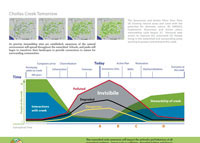 |
 |
 |
This watershed-wide awareness will impact the attitudes and behaviors of all watershed residents. Issues such as pollution, degraded habitat and danger will diminish. The visibility of the creek will become realized as people are connected with nature. This is our vision for the Chollas Watershed.
(Photo: Garrison, C.C. LaGrange, Mario Benito, Emily Kiefer, Google Maps 2007, http://history.sandiego.edu) |
 |
 |
|
 |